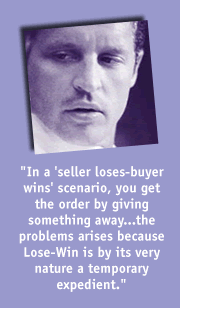
"Buying the Business" Usually Means Trouble
| Продажи | ||||
| Sales.com | ||||
| Negotiat... | ||||
by Stephen E. Heiman, Diane Sanchez with Tad Tuleja
Win-Win. By now, you're probably sick of hearing the phrase. It's everywhere -- in books and magazines, on commercials and infomercials, and probably on the whiteboard in your office. It's become a part of our culture. While most of us are all too familiar with the concept, and while we recognize Win-Win as the ultimate goal in business, many still believe - or hope - that there are other happy endings, like Lose-Win.
 In
a ":seller loses-buyer wins": scenario, you get the order by giving something
away - by allowing yourself and your company to lose in the hope that
you will make it back in future sales. Maybe you offer the customer a
ridiculously low introductory price, or a special volume discount, or
service commitments that are out of this world. Whatever it is - time,
terms, price, training, financing - you're essentially saying to the customer,
":I'm letting you win at my expense because I value your business.":
In
a ":seller loses-buyer wins": scenario, you get the order by giving something
away - by allowing yourself and your company to lose in the hope that
you will make it back in future sales. Maybe you offer the customer a
ridiculously low introductory price, or a special volume discount, or
service commitments that are out of this world. Whatever it is - time,
terms, price, training, financing - you're essentially saying to the customer,
":I'm letting you win at my expense because I value your business.":
There's nothing fundamentally wrong with a ":loss leader": or ":investment": strategy; retail stores use it all the time, often with good results. The problems arise because Lose-Win is by its very nature a temporary expedient. It cannot possibly be offered, to any customer, every time - and yet that's exactly the way many of its recipients read it.
You offer a customer an extraordinary payment schedule on an initial contract as a way of attracting her business. You know it's only a one-time, special arrangement, but she doesn't get that message. She thinks the extraordinary schedule is typical. Therefore, when contract renewal time comes up and you tell her, ":We'll have to return to our normal payment schedule for this contract,": she acts like you've just stolen her car. ":What do you mean, 'normal'? I thought we had a deal!": You did have a deal, but your customer has failed to appreciate its temporary nature. And she's fallen victim to the curse of Lose-Win: false expectations.
Think of the ridiculously low introductory finance rates that credit card companies offer to lure new customers. The rates are attractive, without question - sometimes as low as 2 or 3 percent. But after the introductory periods (usually three to six months), customers suddenly find themselves paying the usual usurious rates - 18 or 20 percent - and many of them transfer their balances to another loss-leader offer. This kind of ":card hopping": is an irritating game for everybody concerned, and it provides no long-term stability for the credit card companies. Nonetheless, it's a predictable response because Lose-Win is a natural invitation to customer disappointment.
When you employ a Lose-Win strategy, therefore, you can anticipate one of two problems. Your customers will suspect there's a trick involved (since we all know you don't get something for nothing) and back out of the room with their hands on their wallets. Or they will buy in to the Lose-Win option expecting it to go on forever.
It's not always the seller who sets up the false expectations. Many customers ask for Lose-Win because they believe (mistakenly) that it's to their long-term advantage. A client will demand a better credit structure or a more favorable price than she, or anyone else, has ever gotten in the past - because she knows you want her business so badly that you're willing to hock the store to get it. The interesting thing here is that such a customer, far from stealing a march on the ":sucker": salesperson, is usually just setting up her own false expectations and therefore setting herself up to lose.
The bottom-line lesson is the same. No matter who initiates the idea of Lose-Win, it's almost always, in the long run, a double-fault game.
Adapted from The New Conceptual Selling Stephen E. Heiman, Diane Sanchez with Tad Tuleja (c) 1999 by Miller Heiman, Inc., All rights reserved with permission of Warner Books. Inc.